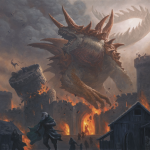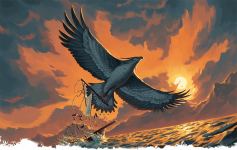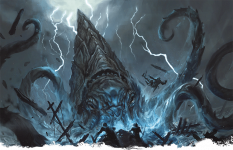Continuing through the 2024 MM, it brings up some things that haven't changed much. One of them is that the reach and damage of the Gargantuan creatures seems woefully small compared to their descriptions.
I get the desire for game balance and fun, the big hp totals and defenses some of them have, the legendary attacks giving them extra chances to deal damage, not wanting too many party members to be one shot, and that the Swallow attack is pretty cool.
But why is something that is 70' tall and can destroy buildings and boats and might even be "the most devastating creatures in existence" only able to reach 15 feet away and take two or three hits with the tails or claws to finish off a run of the mill Polar Bear, Knight, or Ogre?
(I assume the second paragraph answers the third, but I still find it unsatisfying).
For reference, here is the damage and reach of the much, much smaller T-rex
Tyrannosaurus Rex (Huge; 20 feet tall/40 feet length by google)
Bite, reach 10 ft. 33 damage
Tail, reach 15 ft. 25 damage.
and the hit points of some creatures to see how many hits it would take these legendary creatures to get rid of:
Tyrannosaurus Rex - 136 hit points
Elephant - 76 hit points
Ogre - 68 hit points
Knight - 52 hit points
Hunter Shark (Large) or Rhinoceros - 45 hit points
Polar Bear - 42 hit points
Tiger - 30 hit points
-----
Tarrasque

"Among the most devastating creatures in existence, the tarrasque is an engine of catastrophe and a ruiner of nations. A terror of massive size and overwhelming might, this primeval destroyer survives from the earliest epochs of the Material Plane, when it served as a weapon of immortal forces.
The tarrasque is a bipedal, prehistoric Monstrosity that stands over seventy feet tall."
Bite, reach 15 ft. 36 damage.
Claws, reach 15 ft. 28 damage.
Tail, reach 30 ft. 23 damage.
--------
Dragon Turtle

"Dragon turtles are mighty creatures with shells large enough to be mistaken for islands and jaws capable of snapping ships like twigs."
Bite, reach 15 ft. 23 damage.
Tail, reach 15 ft. 18 damage.
--------
Roc

"Birds of prey of fantastic scale, rocs hunt over vast territories and can snatch whole elephants, whales, or wagons in their talons.
Beak, reach 10 ft. 28 damage.
Talons, reach 5 ft. 23 damage.
--------
Kraken

"Ancient weapons of the gods, krakens slumber in the deepest oceanic abysses, awaiting their time to rise and dominate the world. These massive, many-tentacled horrors combine overwhelming physical might with formidable cunning. Their powerful limbs shatter ships and topple spires, and they use their control over storms to rain down lightning on their foes."
Tentacle, reach 30 ft., 24 damage.
I get the desire for game balance and fun, the big hp totals and defenses some of them have, the legendary attacks giving them extra chances to deal damage, not wanting too many party members to be one shot, and that the Swallow attack is pretty cool.
But why is something that is 70' tall and can destroy buildings and boats and might even be "the most devastating creatures in existence" only able to reach 15 feet away and take two or three hits with the tails or claws to finish off a run of the mill Polar Bear, Knight, or Ogre?
(I assume the second paragraph answers the third, but I still find it unsatisfying).
For reference, here is the damage and reach of the much, much smaller T-rex
Tyrannosaurus Rex (Huge; 20 feet tall/40 feet length by google)
Bite, reach 10 ft. 33 damage
Tail, reach 15 ft. 25 damage.
and the hit points of some creatures to see how many hits it would take these legendary creatures to get rid of:
Tyrannosaurus Rex - 136 hit points
Elephant - 76 hit points
Ogre - 68 hit points
Knight - 52 hit points
Hunter Shark (Large) or Rhinoceros - 45 hit points
Polar Bear - 42 hit points
Tiger - 30 hit points
-----
Tarrasque

"Among the most devastating creatures in existence, the tarrasque is an engine of catastrophe and a ruiner of nations. A terror of massive size and overwhelming might, this primeval destroyer survives from the earliest epochs of the Material Plane, when it served as a weapon of immortal forces.
The tarrasque is a bipedal, prehistoric Monstrosity that stands over seventy feet tall."
Bite, reach 15 ft. 36 damage.
Claws, reach 15 ft. 28 damage.
Tail, reach 30 ft. 23 damage.
--------
Dragon Turtle

"Dragon turtles are mighty creatures with shells large enough to be mistaken for islands and jaws capable of snapping ships like twigs."
Bite, reach 15 ft. 23 damage.
Tail, reach 15 ft. 18 damage.
--------
Roc

"Birds of prey of fantastic scale, rocs hunt over vast territories and can snatch whole elephants, whales, or wagons in their talons.
Beak, reach 10 ft. 28 damage.
Talons, reach 5 ft. 23 damage.
--------
Kraken

"Ancient weapons of the gods, krakens slumber in the deepest oceanic abysses, awaiting their time to rise and dominate the world. These massive, many-tentacled horrors combine overwhelming physical might with formidable cunning. Their powerful limbs shatter ships and topple spires, and they use their control over storms to rain down lightning on their foes."
Tentacle, reach 30 ft., 24 damage.
Last edited:
